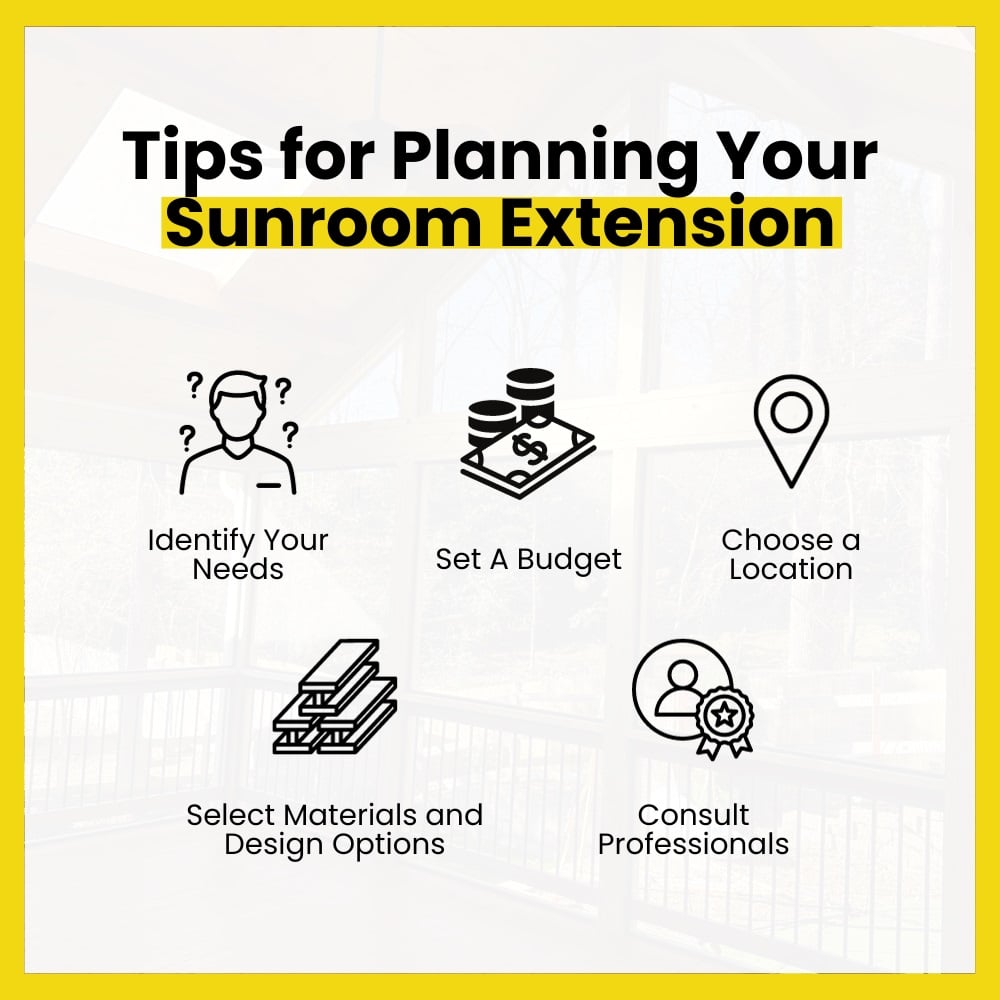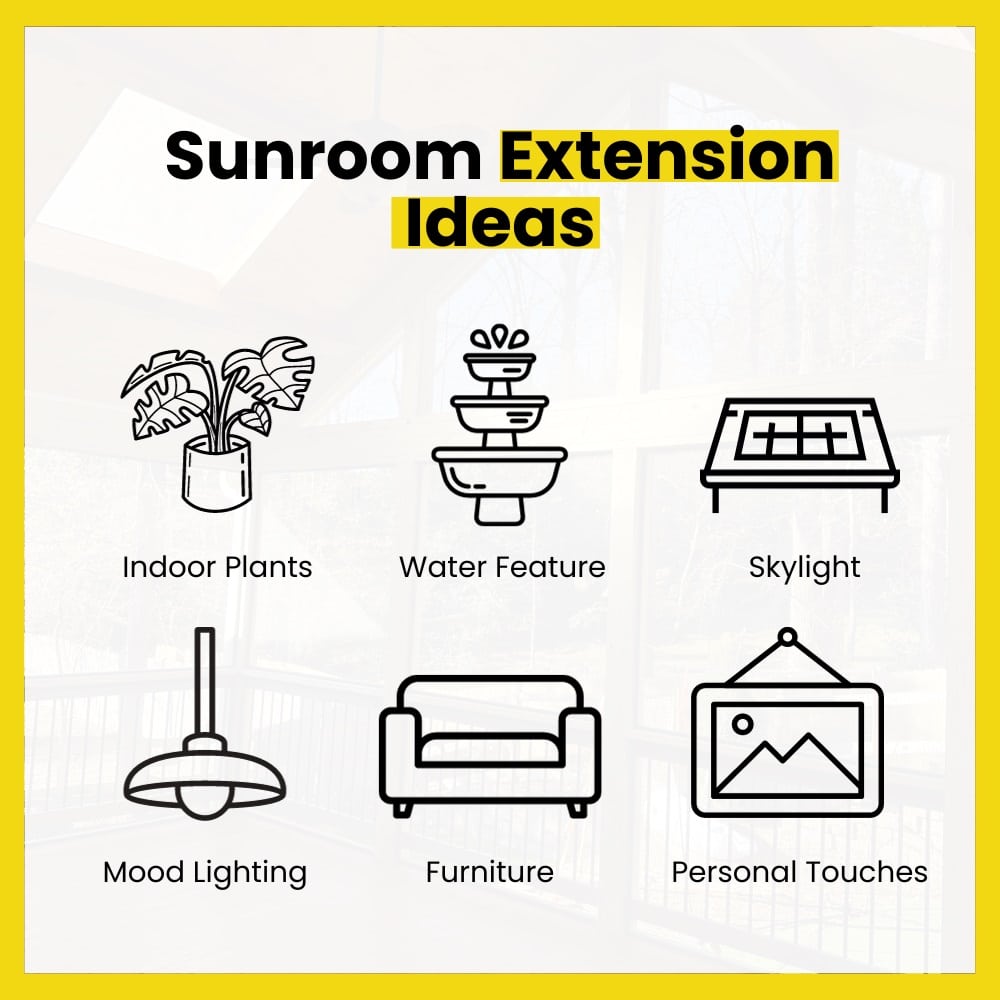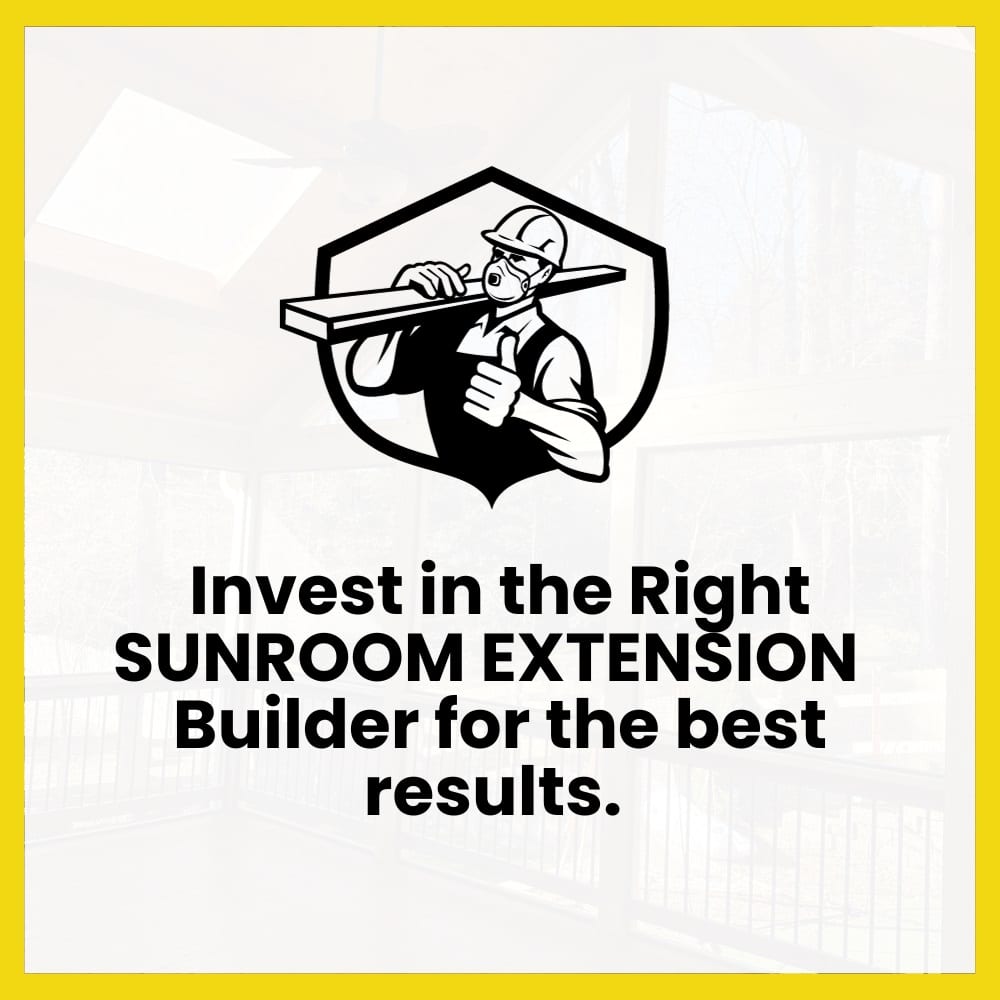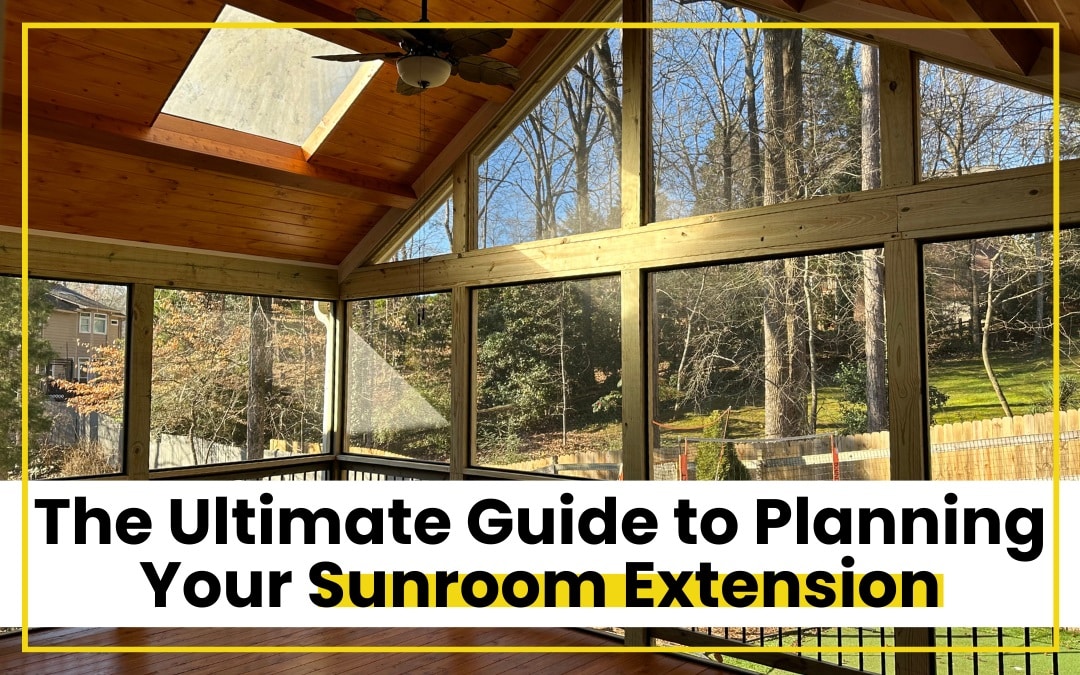Sunroom extensions are versatile spaces that can serve as a relaxing retreat, a space for plants, or even an additional living area.
With the right planning and materials, they can also increase the value of your home.
It’s important to understand the key factors, from setting a budget to selecting the right location and materials.
This guide will provide all the necessary insights and tips to ensure your sunroom extension meets your vision.

Planning Your Sunroom Extension
Adding a sunroom is an exciting project that requires good planning.
This space is a mix of indoor comfort with outdoor views.
To get it right, there are important steps to consider.
We’ll guide you through the main factors, from understanding your needs to working with experts, to make sure your sunroom is both practical and appealing.
Identify Your Needs
Before adding a sunroom extension to your home, it’s essential to understand its purpose.
First, decide on the main use for the room. Do you want a calm space for reading or a lively area for gatherings?
This choice will guide your design and layout decisions.
Next, think about the overall feel. You might want a room filled with plants or a simple space with just a few pieces of furniture.
Your desired atmosphere will influence your choice of furniture, colors, and lighting.
Consider the special features you’d like to add.
For those with a green thumb, maybe plants would be ideal. If you love music, think about installing a sound system.
Finally, make sure your sunroom fits well with the rest of your house. It should look and feel like a natural extension of the existing architecture.
Set a Budget
A clear budget for your sunroom keeps expenses manageable throughout the project.
Decide on the most you’re willing to spend. This sets clear boundaries, so you stick to what’s feasible for your finances.
It’s helpful to split your budget into different categories.
Allocate amounts for materials, labor, and other essentials. This helps you understand where each dollar is going and highlights areas for potential savings.
Remember, projects can have surprises.
To avoid stress, keep a reserve fund for unplanned expenses. This could be for material price hikes or extra work.
Distinguish between ‘must-haves’ and ‘nice-to-haves’ to help you decide where to spend more or cut back.
Choose a Location
If you enjoy mornings, consider an east-facing room. For sunsets, the west is best.
For consistent light without the heat, north-facing is ideal. Meanwhile, south-facing rooms are sunny but may need shade in the summer.
Aim to maximize scenic views without compromising privacy.
Whether overlooking a garden or distant hills, aligning with a view enhances the room’s ambiance.
But make sure it doesn’t put you in full view of neighbors.
Lastly, consider how the sunroom connects to the rest of the house. Close to the kitchen is great for dining, while a spot near the living area suits relaxation.
The key is integrating it with existing outdoor areas, like patios or gardens, for a fluid transition between indoor and outdoor spaces.
It helps to consult with builders in your area so they’re familiar with the unique qualities of your property.
If you reside in Georgia for example, hiring sunroom builders in Atlanta can be a good choice.
Select Materials and Design Options
Choosing the right materials for your sunroom extension is crucial for its look and functionality.
UV-resistant glass can protect interiors from harmful rays, while energy-efficient insulation can manage room temperatures to save on energy costs.
When considering flooring, choose durable choices like tile or vinyl. Especially if the space will see heavy foot traffic.
Your color palette should complement the room’s natural light.
Lighter shades can amplify brightness, while darker tones offer a cozier vibe.
Finally, decide between an open concept or a screened design based on your needs and desired ambiance.
Consult Professionals
Working with professional custom sunroom builders is the smart choice if you want a durable and high-quality sunroom.
These experts are well-versed in local building regulations.
They’ll make sure that your project stays compliant to avoid potential fines or rebuilds.
Their insights on the latest design trends and materials can elevate your sunroom’s appeal. This helps maximize your home’s overall value.
With their assistance, you’ll minimize errors so you can save time and money.

Sunroom Extension Ideas
Making your sunroom extension uniquely yours is where the fun begins.
Here are some sunroom design ideas to infuse personality into your space:
Indoor Plants
Incorporate a variety of indoor plants, from tall palms to cascading vines. This not only boosts the aesthetics but also improves indoor air quality.
Water Feature
A small indoor fountain or a wall-mounted waterfall can bring a calming ambiance. The gentle sound of flowing water can be both relaxing and meditative.
Skylights
Natural light can work wonders. Installing skylights keeps your sunroom well-lit and maintains the room’s warmth.
Mood Lighting
For evenings or cloudy days, consider adding ambient lighting. String lights, pendant lamps, or even lanterns can offer a warm glow.
Furniture Choices
Prioritize comfort. Opt for plush sofas, cushioned chairs, and throws. Depending on the room’s purpose, you might consider adding a hammock or swing chair.
Personal Touches
Don’t forget to include personal elements like family photos, art pieces, or collections. These touches make the room feel truly yours.
Remember, your sunroom extension should reflect your preferences and style.
Whether a minimalist design or a vibrant, eclectic mix, it should be a space where you love spending time.
How Much Does a Sunroom Extension Cost?
Sunroom extensions can cost anywhere from $15,000 to $70,000 on average.
It will depend on factors like the materials you choose, additional features, and the cost of your chosen sunroom builder.
Balancing your design goals with your budget ensures that your sunroom is a value-added investment.
For instance, opting for standard windows might save you money compared to custom, floor-to-ceiling glass panels.
The type of flooring, be it luxury hardwood or budget-friendly laminate, can also swing your costs upward.
Then, there are the ‘extras’ to consider.
If you’re considering adding smart home features or a dedicated heating and cooling system for your sunroom, these will increase the price.
Also, roof choices such as a simple shed style versus a more elaborate gable design, can influence your budget.
Location plays a role too. Labor costs in urban centers, for instance, can be higher than in rural areas.
The need for special permits or adherence to stricter building codes in certain regions can also add to expenses.
Finally, while it might be tempting to go with the cheapest offer, it’s important to assess the quality of work.
Investing more upfront can save substantial amounts in future repair or maintenance costs.

Finding the Right Builder for Your Sunroom Extension
The success of your sunroom extension depends a lot on the builder you choose.
Their expertise, dedication, and knowledge of your needs are essential to bringing your dream sunroom to life.
Don’t leave such a significant investment to chance.
You need to partner with an expert team that shares your commitment to quality and value.
Ready to start work on your sunroom extension?
Request a quote from Perimeter Remodeling and take the first step toward your ideal outdoor oasis.



Recent Comments